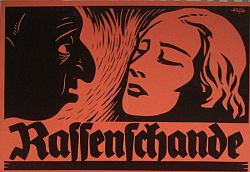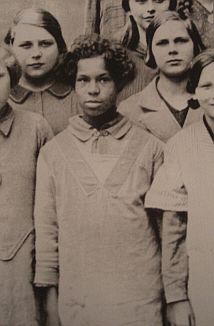In the name of racial purification, the Nazis
forcibly sterilized close to 400 ethnically and
racially "mixed " children in 1937. The fathers of
these children - Black African, Arab, and Vietnamese
colonial soldiers in the French army - belonged to
Allied forces occupying sections of western Germany
along the Rhine river after World War I.
| |
 |
|
| |
Picture: Jewish
Museum, Berlin |
|
The Gestapo coordinated the secret, illegal action.
(The 1933 sterilization law covered only individuals
with specific "genetic diseases.") The police
drafted public health officials and academic experts
to locate the children, examine them for their
racial background, and hand them over in designated
hospitals. Some of the children were examined at
geneticist Otmar von Verschuer's institute for
Heraditary Biology and Racial Hygiene in Frankfurt.
Anthropologist Eugen Fischer and especially his
assistant Wolfgang Abel were significantly involved
in the examinations.
| |
 |
|
| |
Picture: Jewish
Museum, Berlin |
|
A slide used in
lectures on genetics at the State Academy for Race
and Health in Dresden, circa 1936. The Caption reads:
" Mulatte child of a German woman and Negro of the
French Rhineland garrison troopes, among her German
classmates." (Library of Congress, Washington, D.C.).
| |
 |
|
| |
Picture: Jewish
Museum, Berlin |
|
Plates from a 1937
scholarly article by Wolfgang Abel, who studied the
Mischlinge offspring of Maroccan-German and
Vietnamese-German parents. Abel concluded that the
so-called bastards ("hybrids") were physically and
mental´ly "degenerate": "Ot is the mixing of
European with Negroid and Mongoloid races wherein
lies the primary reason for the poor condition of
the Rhineland bastards found in our population." (aus: Zeitschrift
für Morphologie und Anthropologie, 1939,
Universitätsbibliothek Johann Christin Soenckenberg,
Frankfurt a.M.)
| |
 |
|
| |
Wolfgang Abel,
”Bastarde am Rhein”, in: Neues Volk. Blätter
des Rassenpolitischen Amtes der NSDAP,
Leipzig, 2 (1934) |
|
In April, 1933 Hermann Göring asked the heads of the
government of the Rhineland to provide statistics
about age and the amount of colored occupying troops
who had chrildren with German women. In the
governmental district Cologne so-called
"Rheinlandbastarde [Rhineland crossbreeds]" were
found.
The so-called
"Sonderkommission 3 [special commission 3]" from the
Prinz-Albert-Straße, the headquarter of the state
police of (Gestapo) in Berlin, received the order to
sterilize all children of French and American
occupying soldiers from the time of the Rhineland
occupation they had with German women (the so-called
"Rhineland crossbreeds").
The development
initiated ended in 1937 with the sterilization of
those children. They were sterilized in Cologne, for
instance in the Protestant hospital in
Cologne-Weyertal.
|
Navigation with Google Earth (must be
installed) |
|
 |
The Reich Ministry of
the Interior which had investigated for many years
systematically in small companies and in cooperation
with local authorities, welfare associations like
the German charity, now provided the necessary
documents which included every chosen child. After
this top secret procedure was done several hundred
youngsters were sterilised by force. Until today
noone has received compensation. They are not
officially stated as victims of the National
Socialism.
Sources:
•
Bechhaus-Gerst, Marianne, Afrikanische
Kriegsgefangene und
Besatzungssoldaten in Wahn
•
"Besondere Kennzeichen Neger" - Schwarze im
NS-Staat. Ein
Ausstellungsprojekt des NS-Dokumentationszentrums Köln
•
Huck, Jürgen 1971. Die Garnison. (Unser Porz.
Beiträge zur
Geschichte von Amt und Stadt Porz, Heft
11.). Porz, Rh.: Verlag
des Heimatvereins.
•
Pommerin, Reiner 1979. „Sterilisierung der
Rheinlandbastarde.“
Das Schicksal einer farbigen
deutschen Minderheit. Düsseldorf:
Droste Verlag.